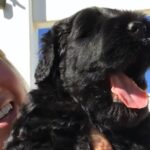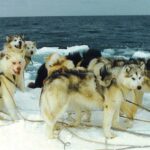Interview with Scott & Kathy Shifflett, Breeders of Kurly Kreek Curly-Coated Retrievers
- Please tell us a little bit about yourself. Where do you live? How many years in dogs? How many years as a breeder? What is your kennel name?
- What is your “process” for selecting show puppies? Performance puppies?
- In your opinion, is your breed in good condition overall? Any trends that warrant concern?
- As a Preservation Breeder, can you share your thoughts on the sport today? How’s the judging these days? What do you think about the number of shows?
- In your opinion, is social media good for the sport? Is it harmful?
- What are the biggest challenges facing the dog show community as a whole today and how can these be addressed?
- What are some of the positive changes you’ve seen in the sport over the past decade?
1. We live in Tracys Landing, Maryland. Scott and I have had dogs our entire lives, along with many other animals. We acquired our first Curly-Coated Retriever (CCR) in 1993 and bred our first litter in 1997.
2. When we breed a litter, we are looking for the “wow” puppy that has the potential to excel in all aspects of what a CCR can do. A CCR is a dual-purpose dog. These dogs can be great Conformation dogs (of course, always looking for breeding stock), great companion dogs, great performance dogs (Field, Obedience, Rally, Dock Diving Fast CAT, Barn Hunt, etc.). For field dogs that show drive, we work with the puppies with bird wings and baby bumpers to see if they have the desire to pick up the wings or bumpers. Most of them do. When evaluating the conformation of a puppy, we evaluate the puppies at seven weeks. However, we are watching them daily and note their interaction with the other puppies and with us. We look at the total puppy and evaluate it against the CCR Breed Standard. We look at shoulder layback, length of back, topline, strong hind quarters, tail set, etc. We watch them move freely. We watch them interact with different distractions and apparatus.
3. When looking at the history of the CCR, the breed characteristics have remained unchanged, for the most part. I believe this speaks well for our breeders as we are maintaining the dual purpose of the CCR breed. However, the CCR, along with many other breeds, is facing many challenges. There are ebbs and flows in the issues we face. At this point in time, we are seeing dogs with weak rears. As breeders, we need to consider this problem and try to establish a breeding program that will promote a stronger rear without losing the corrections we have made over the years.
4. As a preservation breeder, we are maintaining the original purpose of the CCR as a retrieving gundog on land and in water, as well as maintaining the Breed Standard as set forth by the parent club. With all the negativity surrounding purebred dogs these days, it is a tough road. There are a lot of multi-day clusters which can sometimes keep dogs and handlers on the road for weeks at a time. One needs to consider whether the handler/owner has the capability to adequately maintain the health, safety, and condition of the dogs while on these long trips. As far as judging, the CCR is a low-entry breed, so there may be many weekends/shows that judges do not have the opportunity to see a CCR in the Breed or Group ring. In my opinion, because we are a low-entry breed, the best CCR may be overlooked by many judges in the Group ring.
5. Social media has its place in communications in all walks of life. It is a means to communicate with others. However, it should always be done in a professional manner. I do feel as though there are times when it is misused. Social media, in some cases, has aided in communicating with individuals from other countries.
6. Obtaining adequate facilities to hold dog shows (Conformation, Agility, Obedience/Rally, and Field Events, etc.) is getting more and more difficult. Having enough judges who are qualified to judge Conformation is becoming a problem. I enjoy showing to a judge who enjoys the job they are doing and takes it seriously. In the Conformation ring, judges are supposed to be judging breeding stock, and therefore, should be examining the dog and measuring it against the Breed Standard. As a breeder, we show our dogs and finish their championship title from the Bred-By class. Legislation, both state and federal, is worrisome. In this regard, our community isn’t often heard. AKC’s legislative efforts do a great job in getting communications out to the fancy, making us aware of potential legislation—either good or bad. They encourage us to contact our representatives, and oftentimes, give us writing points. I feel as though the legislatures do not understand the canine world when it comes to dog events. Some of the legislation is harmful to our sport as well as the breeding programs that many breeders have developed to preserve the breeds over the years.
7. One of the positive changes in the Conformation classes is the addition of the 6-12 Month Bred-By class. This has made a difference. Prior to the AKC dividing the Bred-By class into the 6-12 Month and the Adult classes, there were judges who did not think that 6–9-month puppies should be shown in the Bred-By class because of their age. However, as a breeder, I want to finish my dogs from the Bred-By class. We are very proud of the number of puppies that we have finished by showing in Bred-By. I know other breeders, both CCR breeders and others, who have the same feelings. Also, the 4-6 Month Beginner Puppy competitions are very helpful to get a young dog started. It also encourages some new puppy owners to give Conformation and showing a shot.








